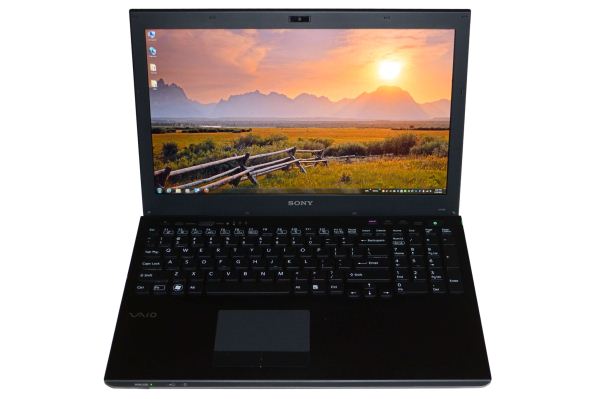Sony VAIO SE: An IPS Laptop for Under a Grand
by Jarred Walton on April 3, 2012 5:40 PM ESTConclusion: All About IPS
When all is said and done, there’s really one item that sets the VAIO SE apart from other laptops in its price range: the 1080p IPS display. You can find laptops with decent 1080p TN panels for about the same price (e.g. the Dell XPS 15z with 1080p upgrade), and you can certainly find a lot of faster laptops and notebooks, particularly if gaming is what you’re after. What you simply can’t find is a laptop with an IPS display that can still play games, all without breaking the bank.
The Sony VAIO SE isn’t a perfect laptop by any means. My biggest issues are build quality and the switchable graphics. I have no problem with the AMD HD graphics (at least the HD 6630M—the 6470M is pretty much DOA as far as I’m concerned), but AMD’s graphics switching technology just feels outdated. NVIDIA’s Optimus Technology switches on-the-fly between IGP and discrete graphics as needed, you can still get driver updates from NVIDIA and Intel without worrying about compatibility issues, and the single valid complaint I’ve seen against Optimus is that there’s (currently) no workable solution for Linux users. Given the driver compatibility issues I encountered with the VAIO SE (not to mention the VAIO CA we looked at in September), it’s pretty clear to me that any compatibility concerns with Optimus are only going to be worse if you’re looking at AMD’s alternatives.
Regarding build quality, I understand Sony’s point about going lightweight and thin, but I’m just not convinced that was the best decision. I would like to see a more rigid LCD/cover, and the hinge is quite loose for a new laptop—I can only imagine what it will feel like after a year or two of daily use. The main body of the laptop feels so much better than the display and hinge that I can’t believe these elements all exist on the same laptop. A solid feeling magnesium alloy frame is something I usually see with higher spec laptops (e.g. ThinkPads, Latitudes, and EliteBooks), and I would gladly sacrifice 0.05” of thickness to get a similar treatment for the top cover. I’d also like to see the hinge moved up so that it doesn’t block the sole exhaust port.
But really, if you’re not planning on playing a ton of games or running GPU intensive tasks, the only major concern that remains for me is the hinge and how it will hold up long-term. Counter that with a sub-$1000 price tag for a mainstream laptop that can do everything you’re likely to want, plus you get a 1080p IPS display. For everyone that looks at our laptop reviews and says, “Oh, please, not another pathetic 1366x768 display on a 15” laptop!”, the VAIO SE is for you.
Taking a quick look at the competition, here’s how things play out right now. Dell has their XPS 15z (which we reviewed here), and it’s priced similarly to the VAIO SE; get that with a 1080p display and Dell will currently charge $1300, but you can find a much better price elsewhere: $1080 for i7-2640M, 6GB RAM, 1080p LCD, plus all the other typical stuff; that’s a good deal. The VAIO SE display is better and it’s much easier to upgrade the HDD and memory than the 15z, but the 15z hinge seems better to me and Optimus trumps AMD manually switching graphics. Another potential option is the HP Envy series; the Envy 15 looks quite nice, and it has a faster HD 7690M GPU than the VAIO’s HD 6630M, but you lose the battery life offered by switchable graphics. It will also set you back $1250 with the 1080p “Radiance display” (which is reportedly the same IPS panel as the VAIO SE) and you “only” get an i5-2450M CPU. All told, I’d give the Envy 15 the edge in overall build quality, but it loses in form factor and battery life. The HP Envy 14 Spectre is another option, but it’s priced quite a bit higher (smaller means more expensive at this range), and you get a ULV CPU in the process. Finally, the only other “mainstream IPS” laptop we haven’t mentioned is the Lenovo ThinkPad X220; it’s smaller, it has a 1366x768 LCD, and the color gamut (and likely color issues) are similar to what you get from the VAIO SE. You also lose out on the discrete GPU and you pay $1250, so it’s basically better build quality and portability for more money and less performance.
 If you’re tired of lackluster TN panels and are looking for something better, I have no qualms about recommending the VAIO SE and its 1080p IPS display. The display is a big enough step in the right direction that it elevates the VAIO SE above most of its peers, provided you’re willing to live with a few compromises. I’ve been using the SE for the past month or so, doing plenty of typing and web surfing on it, and I’ve been very happy with the experience. You can read all of our quibbles about build quality and drivers, but at the end of the day if you just want a laptop that’s good for web browsing, office work, and multimedia—and you want IPS viewing angles without demanding perfect colors—the VAIO SE delivers. We’re awarding it our Bronze Editors’ Choice award for doing many things right (just like the Dell XPS 15z), and for hopefully shoving the laptop display market in the right direction.
If you’re tired of lackluster TN panels and are looking for something better, I have no qualms about recommending the VAIO SE and its 1080p IPS display. The display is a big enough step in the right direction that it elevates the VAIO SE above most of its peers, provided you’re willing to live with a few compromises. I’ve been using the SE for the past month or so, doing plenty of typing and web surfing on it, and I’ve been very happy with the experience. You can read all of our quibbles about build quality and drivers, but at the end of the day if you just want a laptop that’s good for web browsing, office work, and multimedia—and you want IPS viewing angles without demanding perfect colors—the VAIO SE delivers. We’re awarding it our Bronze Editors’ Choice award for doing many things right (just like the Dell XPS 15z), and for hopefully shoving the laptop display market in the right direction.
In fact, the only major reason to not consider the VAIO SE right now is the lateness of the hour. Ivy Bridge is right around the corner, and AMD and NVIDIA have just revamped their mobile GPU offerings. It’s a given that Sony will release a new variant of the VAIO SE at some point relatively soon. If they can address the few design flaws in the VAIO SE and give us something like a GeForce GT 640M with Optimus, that will be the laptop to beat come summer time.











59 Comments
View All Comments
slashbinslashbash - Tuesday, April 3, 2012 - link
When I look at the MBP review, I see Windows laptops on some of the graphs and charts. Especially the ones about color gamut, etc. I would like to see a straight-up comparison. Put OSX *or* Windows on the MBP, MBA, etc. and include those numbers in the tests for battery life, display quality, heat, etc. I understand that some benchmarks only run on Windows, and even if they are available for OSX then it might not be fair to compare between the two because of the OS differences. I get it. So put Windows on an MBA or MBP using Boot Camp and include them in your comparisons. Some things, like h.264 playback battery life, might make sense to test under OSX and include as a direct comparison with Windows machines. Do that if you feel like it. If not, the same test with the MBP running Windows is good too.Every laptop that is reviewed on AT, I eventually end up comparing to the MBP. Please make this easier for me to do so I'm not switching back and forth all the time. There are plenty of people out there who use a MBP as a Windows-only machine. (I'm not one of them, but I do run Windows 7 in Parallels.) The MBP has a reputation as setting a standard. Please start including it as such. No need for a full article on it, just start including the numbers in your charts. Thanks.
ananduser - Tuesday, April 3, 2012 - link
Let me make it easier. The mbp 13" with a 1280x TN screen, integrated graphics and 4 GB RAM costs 1200$(In Europe it costs about 1500$). Now compare it with this SE and every other suggestion at the end of this review. And if you're thinking about bootcamp, "add" at least a 30% battery penalty.kenyee - Tuesday, April 3, 2012 - link
Besides crap displays, that's my other beef w/ laptops nowadays. I still want to shove 16GB in one for VMs, photoshop, premiere pro...zaccun - Wednesday, April 4, 2012 - link
Then you should be buying a workstation machine with 4 slots for ram like a Lenovo W520!(For real, that's what workstations are there for. And they even have good screen options, too.)
Pirks - Tuesday, April 3, 2012 - link
Hence I immediately ordered it at store.sony.com, came out $1190 total with base + 6630 GPU + windows 7 pro + taxes + express delivery, plus FREE Sony dock station (promotion until April 14, hurry up folks!)Hehe, this is something to pwn a few MacBook 15 toting friends of mine, I gonna have a few nasty surprises for them hehehee like much better IPS screen with better resolution and viewing angles, lighter weight and ability to extend battery life to 12 hours, I gonna enjoy their smug little faces when I'll be demoing this new baby to them hehee :)))
JarredWalton - Tuesday, April 3, 2012 - link
Only thing is that MBP15 is still built better than the VAIO SE, particularly on the cover/display/hinge. But in terms of bang for the buck, it's definitely a good laptop.ananduser - Wednesday, April 4, 2012 - link
The MBP15 is more expensive; pricewise, his acquisition should be compared with the entry level mbp13. I mean come on that entry level is a tough buy until a potential refresh later this year.JarredWalton - Wednesday, April 4, 2012 - link
Which is what I imply when I say, "in terms of bang for the buck, it's definitely a good laptop." No one (sane) buys MBP because of value. You buy for the build quality and overall quality, and you buy to run OS X.Personally, I hate using OS X -- I don't feel any urge to learn how to use it. I'd rather use Linux than OS X, but I don't even want to do that. I'm comfortable and happy with Windows, MacBooks lose battery life and other optimizations under Windows, so unless you want OS X with the option to run Windows on occasion, I'd find something non-Apple rather than going the Bootcamp route.
goobah - Tuesday, April 3, 2012 - link
Wheres the castle in the first display shot ?JarredWalton - Wednesday, April 4, 2012 - link
I wondered if someone was going to ask that... it's from Microsoft's UK wallpapers. They're not enabled by default for the US, but you can find other regional themes in:C:\Windows\Globalization\MCT
Copy the appropriate folders to C:\Windows\Web\Wallpaper and you can use them. :-)